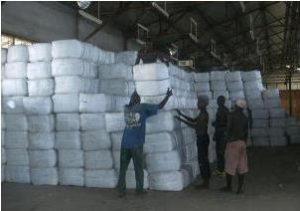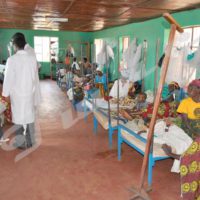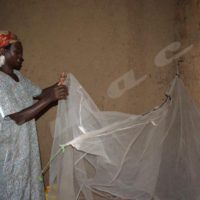
Piles of insecticide-treated mosquito-nets
The Minister of Public Health, Josiane Nijimbere, has launched a campaign of distributing insecticide-treated mosquito-nets (ITN) to special groups like boarding schools, orphanages, military and police camps, refugee camps and the like.
The campaign endeavours to fight the malaria epidemic that is currently a serious health threat to the country. The Integrated National Programme against Malaria (PNILP), a specialised programme of the Ministry of Health, says the epidemic has alarmingly increased over the last three years.
Félicien Ndayizeye, Advisor within PNLIP, estimates that more than 3 000 of over 6 million registered malaria patients have died so far in 2016, while the death toll was 3799 in 2015, the highest number from 2000 according to 2016 WHO report. The number of registered malaria cases was over 5 million, says Ndayizeye.
The mosquito-borne epidemic, that mostly affects children under five and pregnant women, is the first cause of death in Burundi. Ndayizeye says the disease was responsible for 39.4% of deaths in hospitals and its rate of incidence was 54% in 2015.
Different sources in the PNLIP say no study has been carried out to determine factors leading to the persistence and increase of malaria. They, however, agree that possible causes are mainly the effects of climate change such as heavy rains and flood creating favourable conditions for the spread of the disease.
The population is also held responsible for making the fight against malaria more difficult through poor hygienic practices and failure to appropriately use mosquito-nets. Some use the nets to protect their nurseries of vegetables or protect their chicks from predators. PNLIP says the misuse or lack of the use of ITN explains the shift of the regional prevalence of malaria from Bujumbura and the surrounding regions in which it was once prevalent, to up-country regions of the centre, north and east of Burundi.
Ndayizeye also deplores the carelessness of people who go to treatment centres too late which leads to death via aneamia and other complications.
Strategies against the epidemic
The progress of malaria in Burundi defies the efforts PNILP deploys, in accordance with WHO recommendations, for the fight for an eventual eradication of the epidemic. The primary method is the distribution of free insecticide-treated mosquito-nets for the prevention of the disease. The nets are primarily given to pregnant women at their first monthly checkup and to 9 months old infants when they are brought to medical centres for measles immunization.
The 2016 WHO report says that approximately 80% of Burundi population slept under ITN in 2015 which makes Burundi rank second after Sao Tomé and Principle in Sub-Saharan Africa. In the strategy to eradicate the epidemic, PNLIP plans to distribute ITN to all the population in 2017.
Ndayizeye says women are given Intermittent Preventive Treatment in pregnancy (IPTp) with sulfadoxine-pyrimethamine. WHO says “the treatment, administered at each scheduled antenatal care visit after the first trimester, can prevent maternal and infant mortality, anaemia, and the other adverse effects of malaria in pregnancy”.
Another method that PNLIP uses to control the epidemic is indoor residual spraying (IRS). But Dr Ndayizeye says that the lack of sufficient financial means is the challenge in this domain. According to 2016 WHO report, this method was almost not applied in Burundi like in many other countries endemic of malaria except Sao Tomé and Principle where more than 70% of the population slept protected by IRS in 2015.
WHO says in 2015 Burundi ranked 5th along with Central African Republic in malaria cases in Sub-Saharan Africa with its share being 4% of all cases after Democratic Republic of the Congo (57%), Cameroon (16%) and Angola (9%). In Burundi, funds to fight against malaria come mainly from the Global Funds, USAID, the Government and other partners according to PNILP sources.



















 IWACU Open Data
IWACU Open Data

